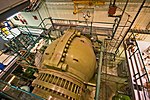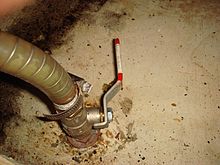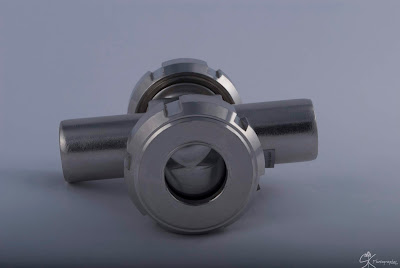#ValveMaintainance
VALVES MAINTENANCE
The simplest, and very ancient, valve is simply a freely hinged flap which drops to obstruct fluid (gas or liquid) flow in one direction, but is pushed open by flow in the opposite direction. This is called a check valve, as it prevents or "checks" the flow in one direction. Modern control valves may regulate pressure or flow downstream and operate on sophisticated automation systems.
Valves have many uses, including controlling water for irrigation, industrial uses for controlling processes, residential uses such as on/off and pressure control to dish and clothes washers and taps in the home. Even aerosols have a tiny valve built in. Valves are also used in the military and transport sectors.
https://en.wikipedia.org/wiki/Valve
Valves everywhere
Valves are found in virtually every industrial process, including water and sewage processing, mining, power generation, processing of oil, gas and petroleum, food manufacturing, chemical and plastic manufacturing and many other fields.People in developed nations use valves in their daily lives, including plumbing valves, such as taps for tap water, gas control valves on cookers, small valves fitted to washing machines and dishwashers, safety devices fitted to hot water systems, and poppet valves in car engines.
In nature there are valves, for example one-way valves in veins controlling the blood circulation, and heart valves controlling the flow of blood in the chambers of the heart and maintaining the correct pumping action.
Valves may be operated manually, either by a handle, lever, pedal or wheel. Valves may also be automatic, driven by changes in pressure, temperature, or flow. These changes may act upon a diaphragm or a piston which in turn activates the valve, examples of this type of valve found commonly are safety valves fitted to hot water systems or boilers.
More complex control systems using valves requiring automatic control based on an external input (i.e., regulating flow through a pipe to a changing set point) require an actuator. An actuator will stroke the valve depending on its input and set-up, allowing the valve to be positioned accurately, and allowing control over a variety of requirements.
Variation
Valves vary widely in form and application. Sizes[ambiguous] typically range from 0.1 mm to 60 cm. Special valves can have a diameter exceeding 5 meters.[which?]Valve costs range from simple inexpensive disposable valves to specialized valves which cost thousands of US dollars per inch of the diameter of the valve.
Disposable valves may be found in common household items including mini-pump dispensers and aerosol cans.
A common use of the term valve refers to the poppet valves found in the vast majority of modern internal combustion engines such as those in most fossil fuel powered vehicles which are used to control the intake of the fuel-air mixture and allow exhaust gas venting.
Types
Valves are quite diverse and may be classified into a number of basic types. Valves may also be classified by how they are actuated:- Hydraulic
- Pneumatic
- Manual
- Solenoid valve
- Motor
Components
Cross-sectional diagram of an open globe valve.
1. body
2. ports
3. seat
4. stem
5. disc when valve is open
6. handle or handwheel when valve is open
7. bonnet
8. packing
9. gland nut
10. fluid flow when valve is open
11. position of disc if valve were shut
12. position of handle or handwheel if valve were shut
1. body
2. ports
3. seat
4. stem
5. disc when valve is open
6. handle or handwheel when valve is open
7. bonnet
8. packing
9. gland nut
10. fluid flow when valve is open
11. position of disc if valve were shut
12. position of handle or handwheel if valve were shut
Body
The valve's body is the outer casing of most or all of the valve that contains the internal parts or trim. The bonnet is the part of the encasing through which the stem (see below) passes and that forms a guide and seal for the stem. The bonnet typically screws into or is bolted to the valve body.Valve bodies are usually metallic or plastic. Brass, bronze, gunmetal, cast iron, steel, alloy steels and stainless steels are very common.[1] Seawater applications, like desalination plants, often use duplex valves, as well as super duplex valves, due to their corrosion resistant properties, particularly against warm seawater. Alloy 20 valves are typically used in sulphuric acid plants, whilst monel valves are used in hydrofluoric acid (HF Acid) plants. Hastelloy valves are often used in high temperature applications, such as nuclear plants, whilst inconel valves are often used in hydrogen applications. Plastic bodies are used for relatively low pressures and temperatures. PVC, PP, PVDF and glass-reinforced nylon are common plastics used for valve bodies.[citation needed]
Bonnet
A bonnet acts as a cover on the valve body. It is commonly semi-permanently screwed into the valve body or bolted onto it. During manufacture of the valve, the internal parts are put into the body and then the bonnet is attached to hold everything together inside. To access internal parts of a valve, a user would take off the bonnet, usually for maintenance. Many valves do not have bonnets; for example, plug valves usually do not have bonnets. Many ball valves do not have bonnets since the valve body is put together in a different style, such as being screwed together at the middle of the valve body.Ports
Ports are passages that allow fluid to pass through the valve. Ports are obstructed by the valve member or disc to control flow. Valves most commonly have 2 ports, but may have as many as 20. The valve is almost always connected at its ports to pipes or other components. Connection methods include threadings, compression fittings, glue, cement, flanges, or welding.Handle or actuator
A handle is used to manually control a valve from outside the valve body. Automatically controlled valves often do not have handles, but some may have a handle (or something similar) anyway to manually override automatic control, such as a stop-check valve. An actuator is a mechanism or device to automatically or remotely control a valve from outside the body. Some valves have neither handle nor actuator because they automatically control themselves from inside; for example, check valves and relief valves may have neither.Disc

Valve disc
Seat
The seat is the interior surface of the body which contacts the disc to form a leak-tight seal. In discs that move linearly or swing on a hinge or trunnion, the disc comes into contact with the seat only when the valve is shut. In disks that rotate, the seat is always in contact with the disk, but the area of contact changes as the disc is turned. The seat always remains stationary relative to the body.Seats are classified by whether they are cut directly into the body, or if they are made of a different material:
- Hard seats are integral to the valve body. Nearly all hard seated metal valves have a small amount of leakage.
- Soft seats are fitted to the valve body and made of softer materials such as PTFE or various elastomers such as NBR, EPDM, or FKM depending on the maximum operating temperature.

The shut off butterfly valve for a Francis turbine at Gordon Power Station, Tasmania

Ball valve
Stem
The stem transmits motion from the handle or controlling device to the disc. The stem typically passes through the bonnet when present. In some cases, the stem and the disc can be combined in one piece, or the stem and the handle are combined in one piece.The motion transmitted by the stem may be a linear force, a rotational torque, or some combination of these (Angle valve using torque reactor pin and Hub Assembly). The valve and stem can be threaded such that the stem can be screwed into or out of the valve by turning it in one direction or the other, thus moving the disc back or forth inside the body.[ambiguous] Packing is often used between the stem and the bonnet to maintain a seal. Some valves have no external control and do not need a stem as in most check valves.
Valves whose disc is between the seat and the stem and where the stem moves in a direction into the valve to shut it are normally-seated or front seated. Valves whose seat is between the disc and the stem and where the stem moves in a direction out of the valve to shut it are reverse-seated or back seated. These terms don't apply to valves with no stem or valves using rotors.

Inconel X750 spring
Gaskets
Gaskets are the mechanical seals, or packings, used to prevent the leakage of a gas or fluids from valves.Valve balls
A valve ball is also used for severe duty, high-pressure, high-tolerance applications. They are typically made of stainless steel, titanium, Stellite, Hastelloy, brass, or nickel. They can also be made of different types of plastic, such as ABS, PVC, PP or PVDF.Spring
Many valves have a spring for spring-loading, to normally shift the disc into some position by default but allow control to reposition the disc. Relief valves commonly use a spring to keep the valve shut, but allow excessive pressure to force the valve open against the spring-loading. Coil springs are normally used. Typical spring materials include zinc plated steel, stainless steel, and for high temperature applications Inconel X750.Trim
The internal elements of a valve are collectively referred to as a valve's trim. According to API Standards 600, "Steel Gate Valve-Flanged and Butt-welding Ends, Bolted Bonnets", the trim consists of stem, seating surface in the body, gate seating surface, bushing or a deposited weld for the backseat and stem hole guide, and small internal parts that normally contact the service fluid, excluding the pin that is used to make a stem-to-gate connection (this pin shall be made of an austenitic stainless steel material).Valve operating positions

A seacock for cooling seawater, on a marine diesel engine. Seacocks are usually ball valves, but may be other types as well.
Two-port valves
Operating positions for 2-port valves can be either shut (closed) so that no flow at all goes through, fully open for maximum flow, or sometimes partially open to any degree in between. Many valves are not designed to precisely control intermediate degree of flow; such valves are considered to be either open or shut. Some valves are specially designed to regulate varying amounts of flow. Such valves have been called by various names such as regulating, throttling, metering, or needle valves. For example, needle valves have elongated conically-tapered discs and matching seats for fine flow control. For some valves, there may be a mechanism to indicate by how much the valve is open, but in many cases other indications of flow rate are used, such as separate flow meters.In plants with remote-controlled process operation, such as oil refineries and petrochemical plants, some 2-way valves can be designated as normally closed (NC) or normally open (NO) during regular operation. Examples of normally-closed valves are sampling valves, which are only opened while a sample is taken. Other examples of normally-closed valves are emergency shut-down valves, which are kept open when the system is in operation and will automatically shut by taking away the power supply. This happens when there is a problem with a unit or a section of a fluid system such as a leak in order to isolate the problem from the rest of the system. Examples of normally-open valves are purge-gas supply valves or emergency-relief valves. When there is a problem these valves open (by switching them 'off') causing the unit to be flushed and emptied.
Although many 2-way valves are made in which the flow can go in either direction between the two ports, when a valve is placed into a certain application, flow is often expected to go from one certain port on the upstream side of the valve, to the other port on the downstream side. Pressure regulators are variations of valves in which flow is controlled to produce a certain downstream pressure, if possible. They are often used to control flow of gas from a gas cylinder. A back-pressure regulator is a variation of a valve in which flow is controlled to maintain a certain upstream pressure, if possible.
Three-port valves

Schematic 3 way ball valve: L-shaped ball right, T-shaped left
Three-way ball valves come with a T- or L- shaped fluid passageways inside the rotor. The T valve might be used to permit connection of one inlet to either or both outlets or connection of the two outlets. The L valve could be used to permit disconnection of both or connection of either but not both of two inlets to one outlet.
Shuttle valves automatically connect the higher pressure inlet to the outlet while (in some configurations) preventing flow from one inlet to the other.
Single handle mixer valves produce a variable mixture of hot and cold water at a variable flow rate under control of a single handle.
Thermostatic mixing valves mix hot and cold water to produce a constant temperature in the presence of variable pressures and temperatures on the two input ports.
Four-port valves
A 4-port valve is a valve whose body has four ports equally spaced round the body and the disc has two passages to connect adjacent ports. It is operated with two positions.It can be used to isolate and to simultaneously bypass a sampling cylinder installed on a pressurized water line. It is useful to take a fluid sample without affecting the pressure of a hydraulic system and to avoid degassing (no leak, no gas loss or air entry, no external contamination)....
Control

A sailor aboard a ship operates the wheel controlling a fuel valve.
The fill valve in a toilet water tank is a liquid level-actuated valve. When a high water level is reached, a mechanism shuts the valve which fills the tank.
In some valve designs, the pressure of the flow fluid itself or pressure difference of the flow fluid between the ports automatically controls flow through the valve.
Other considerations
Valves are typically rated for maximum temperature and pressure by the manufacturer. The wetted materials in a valve are usually identified also. Some valves rated at very high pressures are available. When a designer, engineer, or user decides to use a valve for an application, he/she should ensure the rated maximum temperature and pressure are never exceeded and that the wetted materials are compatible with the fluid the valve interior is exposed to. In Europe, valve design and pressure ratings are subject to statutory regulation under the Pressure Equipment Directive 97/23/EC (PED).[2]Some fluid system designs, especially in chemical or power plants, are schematically represented in piping and instrumentation diagrams. In such diagrams, different types of valves are represented by certain symbols.
Valves in good condition should be leak-free. However, valves may eventually wear out from use and develop a leak, either between the inside and outside of the valve or, when the valve is shut to stop flow, between the disc and the seat. A particle trapped between the seat and disc could also cause such leakage.
Images -
 | |
| butterfly valves |
Also visit our site - http://parthvalve.com/
Contact Us -
Email :- pramod@parthvalve.com/sales3@parthvalve.com
Call Us:- +91-9881236139/ 7722005619










































Comments